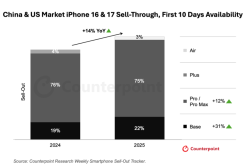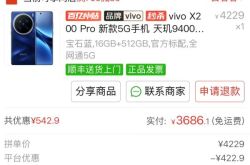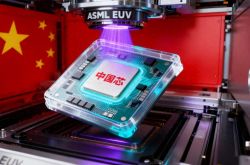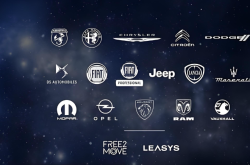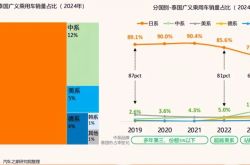"The Centennial Industrial Revelation: Huawei Cloud's Automotive Zone as the 'Philadelphia Moment' for Smart Car Clouds", ["Huawei Cloud", "AI", "Computing Power"]
![]() 09/01 2025
09/01 2025
![]() 651
651
Huawei Cloud's Automotive Zone represents a pivotal milestone in the evolution of cloud vendors' automotive zones, transitioning from a single-zone to a multi-zone setup. This showcase of Huawei's prowess in cloud computing and AI offers efficient, high-quality intelligent cloud services tailored for the smart car industry, addressing critical issues such as equitable intelligent driving rights and service equalization.
In recent years, the emergence of automotive zones by cloud computing providers has been a notable development, intricately linked to the lives of every driver.
In the future, vehicles devoid of internet connectivity and intelligence cannot be deemed 'living cars,' much like a smartphone without internet connectivity holds little practical value.
Cars necessitate intelligence, and the cloud serves as both the pathway and source of this intelligence. The automotive zone acts as the carrier and engine that fuels this intelligent capability.
To some extent, Huawei Cloud's automotive cloud embodies Huawei's strengths across cloud computing, semiconductors, communication technology, storage capacity, AI capabilities, and large model capabilities, converging the core elements of new productivity.
However, Huawei Cloud alone cannot directly catalyze this transformation. It relies on the concerted efforts of new partners, business models, empowerment models, application paradigms, and other components of the industrial ecosystem. Only through such collaboration can it accompany and mutually propel the development of the intelligent era amidst the rising tide.
Thus, the Automotive Zone has emerged, tailored for each of us.
——Introduction
01 From the Centennial Exposition in Philadelphia to the Gui'an Automotive Zone
In 1876, at the Centennial Exposition in Philadelphia, USA, then-President Ulysses S. Grant personally activated the switch to start the powerful 600-ton Corliss steam engine, serving as the main power source. This exposition marked a significant moment in human industrial history, as it was the first time industrial products were subdivided by function based on a classification system (such as Le Prey's design of 10 major categories and 95 fields), reflecting the formation of independent technological paths across various industries.
For instance, Alexander Graham Bell's prototype telephone, the Corliss steam engine (powering machinery throughout the exposition), and the giant steel cannon from Germany's Krupp company represented the specialized development of the communications, power, and military industries, respectively.
This 'categorized' display symbolized a shift from single-technology-driven to multi-track parallel development during the Industrial Revolution, marking the transition from the First to the Second Industrial Revolution. It also set a new gold standard for subsequent industrial revolutions—when an industry evolves from a relatively general model (e.g., Model as a Service) to a segmented track, the firm establishment and robust development of this track indicate the market's maturity, reflecting the prominence of enterprises' differentiated competitiveness.
Less recognized is that many Chinese witnessed this iconic event of the Second Industrial Revolution. Grant met with over 100 young Chinese students studying in the US at the exposition, and many Chinese were deeply moved by this grand exhibition. A Qing dynasty official who attended the exposition wrote, 'To enrich products and thereby facilitate trade is beneficial to the country without unnecessary expense. It is a marvel of the universe, a grand mechanism.'
It remains to be seen whether Huawei Cloud executives standing at the Intelligent Automobile Congress 2025 on August 28 will associate the launch of Huawei's Gui'an Automotive Zone with the Philadelphia Exposition in their hearts. However, as an experienced industry researcher, I believe the emergence of the Gui'an Automotive Zone signifies a landmark shift in the evolution of cloud vendors' automotive zones, transitioning from a single-zone to a multi-zone setup.
This transition from single to multiple is not merely an arithmetic problem; it signifies heightened demands for cloud resources for smart cars and the pursuit of greater stability, implying increased complexity and technological innovation. Essentially, this segmented track has gained a foothold and is witnessing significant development, with significance comparable to the proposal of new classification standards at the Philadelphia Exposition.
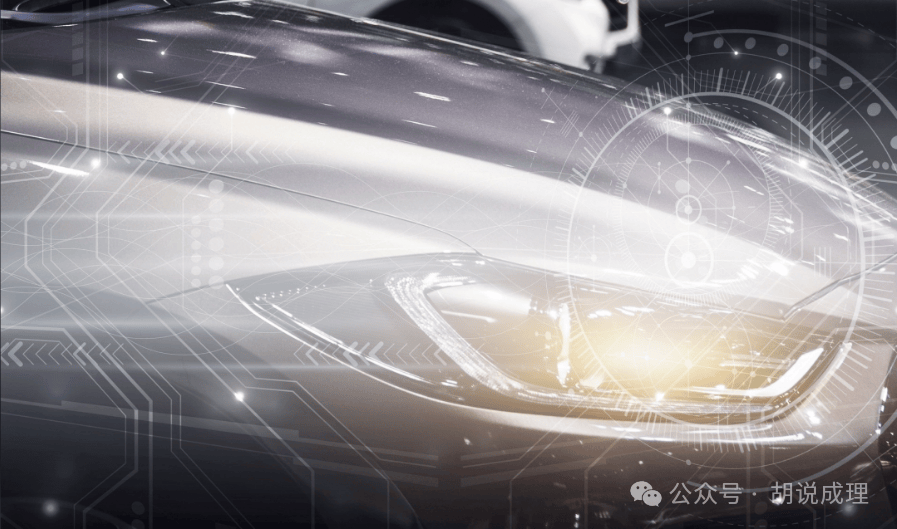
In other words, the development of intelligent cloud services centered around the automotive industry has reached a new stage, becoming the most valuable, challenging, and potentially vast market segment in the cloud industry. It also has the deepest and most tangible direct impact on our end consumers. Huawei's core differentiated competitiveness in its automotive layout has also been further underscored.
The emergence of the Automotive Zone ultimately reflects robust market demand, accelerating the formation of specialized segments in the AI for smart cars track, with Huawei taking a leading position. But what precisely will it bring us?
02 An Obtuse Triangle
If you connect Ulanqab, Gui'an New Area, and Wuhu on a Chinese map, you'll form an obtuse triangle. Geographically, they span northern, southwestern, and eastern China, respectively, creating a widely distributed spatial layout. The area of this obtuse triangle is approximately 10% of China's 9.6 million square kilometers.
This also marks the first time China's cloud computing industry has provided a one-stop multi-zone infrastructure for intelligent assisted driving, encompassing research and development to application and service, through a multi-region and multi-center zone model. The computing power and resources provided by this model are not merely theoretical; they are driven by real demand—IDC data reveals that Huawei Cloud has consistently ranked first in China's automotive cloud market share for three consecutive years.
From another perspective, China's largest intelligent driving enterprise, Yinwang (including familiar models equipped with HarmonyOS Intelligent Drive), operates entirely on Huawei Cloud, currently exceeding 1 million vehicles. For cars that have entered the era of intelligent connectivity, merely being 'connected' means the vehicle is utilizing 'live real-time services.' From this angle, 50 million intelligent connected vehicles are happily 'living' on Huawei Cloud.
However, it is the escalating demand for total computing power for industrial research and development, computer simulation, and the increasingly prominent value of vehicle-cloud collaboration in real-world scenarios that has given rise to Huawei Cloud's 'Automotive Zone.'
Instead of rushing to analyze specific technical characteristics, let's focus on the broader picture—what is the history and current state of the Automotive Zone?
——From a timeline perspective, the emergence of Huawei Cloud's Automotive Zone is a natural consequence of Huawei Cloud's continuous provision of innovative products and services for the automotive intelligent computing track. Since 2009, Huawei has invested in developing in-vehicle modules. From 2014 to 2025, Huawei established its first connected vehicle laboratory, offering end-to-end solutions for automakers across our terminals, pipes, and clouds. Along this journey, we can see that Huawei has consistently increased its investment in the automotive field. Key milestones include: 2019: The release of the Octopus solution, marking Huawei Cloud's initial foray into the intelligent driving field; 2020: The introduction of the vehicle-cloud collaboration solution, further enhancing the collaboration capabilities between vehicles and the cloud; 2023: The launch of Huawei Cloud's Ulanqab Automotive Zone, the country's first 3AZ automotive zone, providing a more robust and stable infrastructure for intelligent driving research and development; 2024: The release of the intelligent driving training solution based on Ascend Cloud, further boosting training efficiency.
In 2025, the Gui'an Automotive Zone was launched, with the Wuhu Automotive Zone also rushing to go live, marking China's possession of world-class automotive cloud infrastructure.

Image: Huawei Cloud Gui'an Automotive Zone Launch Ceremony
——From the perspective of the technology provided by the Automotive Zone, a notable feature is its close alignment with real-world demand. This feature stems from Huawei's Vehicle BU (now Yinwang) having extensive practical experience, including the gradual increase in market share of high-quality intelligent connected vehicles under automakers like Huawei Yinwang, reflecting the industry's enthusiasm for adopting Huawei technologies such as Qiankun Intelligent Assisted Driving. Huawei's vision of 'not making cars, but helping automakers make good cars' is becoming a reality and feeding back into Huawei Cloud's growth in the automotive field.
——From the perspective of improving service quality, it enhances service reliability, reduces latency in real-world scenarios, and further elevates the vehicle-cloud collaboration experience.
While theoretically, the transmission speed of electronic information flow in optical fibers is 300,000 kilometers per minute, this is merely a theoretical figure. From a practical execution standpoint, single-zone solutions with longer physical distances will inevitably experience delays, not only causing lag but also reducing the reliability of real-time processing scenarios. Huawei Cloud recognized early in the research and development of autonomous driving that the core of the intelligent assisted driving experience is to achieve 'slow but not sluggish.' The key to achieving this is to strictly control the vehicle-cloud latency within 40 milliseconds, necessitating the construction of dedicated infrastructure to ensure real-time performance.
More importantly, China's 'Surveying and Mapping Geographic Information Management Regulations' clearly stipulate that geographic information data must be physically isolated. To this end, Huawei adopts an initial 'one south, one north' layout and plans to build a third 3AZ zone in Wuhu. This distributed architecture not only meets national land regulatory requirements but also achieves national coverage. Currently, cloud service providers' automotive zones generally have the limitation of single-point deployment, while Huawei's 3AZ multi-zone architecture offers significant advantages. Such a layout ensures that our cars can enjoy the same intelligent driving services nationwide.

If this sounds a bit obscure, take a look at this chart. The light-colored areas are parts of North China, Northeast China, and Northwest China far from existing zones. The cloud latency in these areas exceeds 40 milliseconds, with some areas in Heilongjiang reaching as high as 60 milliseconds. This means that users in these areas are more likely to experience lag and delays. Whether from the perspective of user experience or fairness, this is a significant issue.
Currently, the concept of equal rights in intelligent driving advocated by automakers like BYD and Changan is becoming the focus of industry concern. Many believe that so-called equal rights in intelligent driving primarily refers to the democratization of high-level autonomous technology. Taking the latest ADS4 as an example, from the entry-level Shangjie priced at over a hundred thousand yuan to the high-end Zunjie priced at over a million yuan, they utilize the same architecture. This is, of course, an important manifestation of equal rights.
However, ADS4 is not merely a product but also a service. If consumers experience disparate intelligent driving experiences solely due to their geographical locations, with some enjoying smooth operations while others encounter lags, then from another perspective, this is also a manifestation of unequal rights in intelligent driving—because owners of the same car model pay the same cost for a vehicle, they have every reason to enjoy the same highly consistent, high-quality vehicle-cloud collaboration services.
With the launch of multiple automotive zones, cloud-assisted vehicles can provide a consistent national experience, with intelligent assisted driving functions operating stably anytime and anywhere.
If equal rights in intelligent driving and service equalization are vital experiences, so is service stability.
We mentioned earlier that the availability of a single zone can reach 99.9%, while that of multiple zones can reach 99.999%. What does this mean?
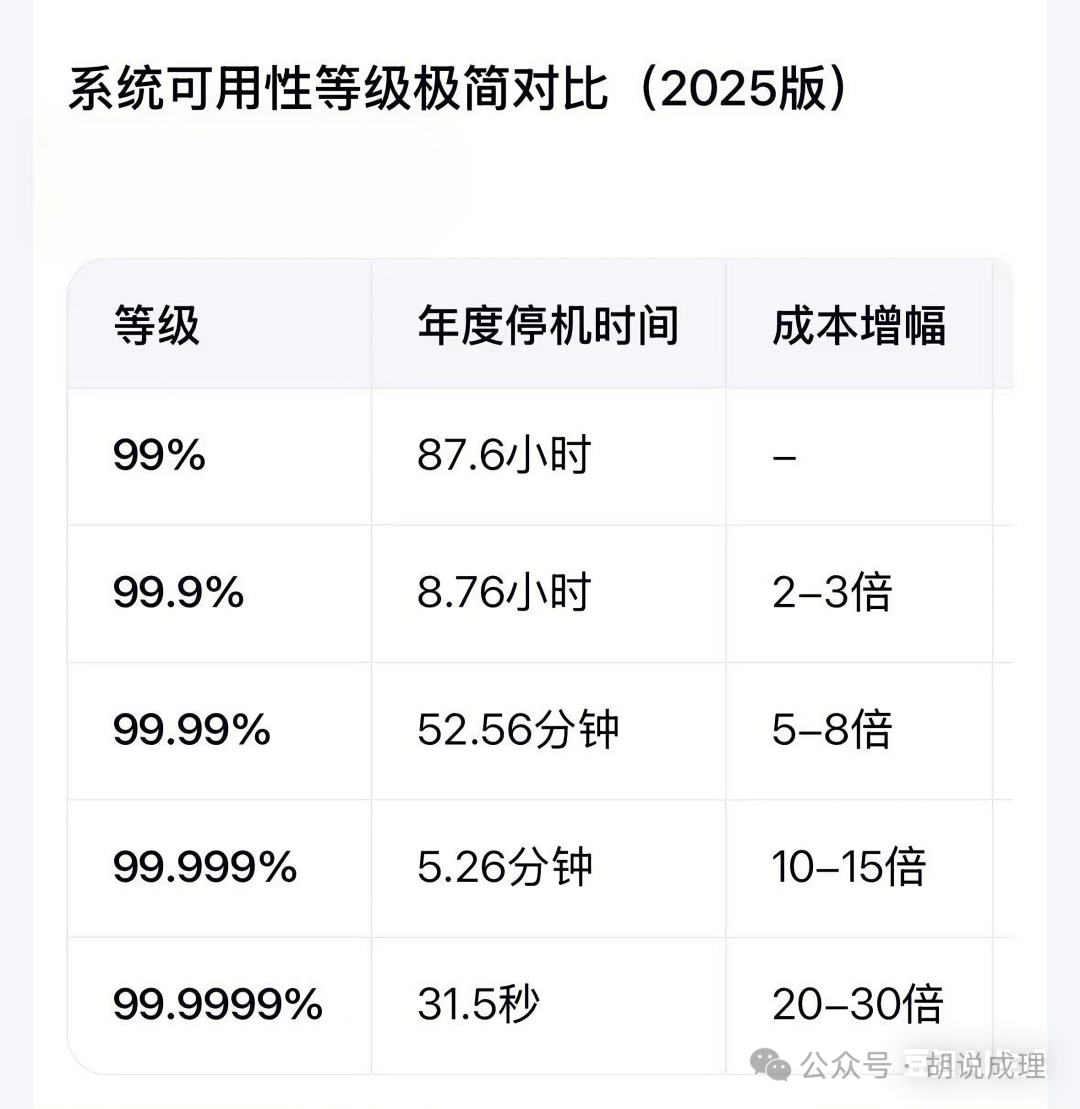
According to common knowledge in operations and maintenance, 99.9% means there will be 525.6 minutes of 'unavailable' time in a year. For each additional '9,' the unavailable downtime is only one-tenth of the previous one. Therefore, the difference between the two is that the former has up to 525.6 minutes of unavailable time, while the latter has only 5.26 minutes.
Making a slightly extreme assumption, if the unavailable time in 99.9% reliability is fully encountered by one car owner (although the probability is extremely low), it means they will experience a prolonged period of being unable to use the app to unlock the car, lag in the in-car system, or even more serious issues. And if the over 500 minutes of unavailable time is presented in a highly fragmented form, it's almost equivalent to an unreliable car usage experience every day, which is detrimental to the owner's experience and the automaker's reputation.
Without delving into the additional significance brought by multiple zones, just from the perspective of ensuring equal rights in intelligent driving, basic user experience, and safeguarding brand reputation, the importance of multiple zones is already immeasurable.
03 What Real Hard Power Does the Automotive Zone Demonstrate?
Objectively speaking, due to China's global leadership in the advancement and possession of intelligent connected vehicles, China's top automotive clouds naturally meet the highest global standards. However, this achievement is also built brick by brick.
First, it is worth mentioning the application of Huawei Cloud's super nodes.
Currently, NVIDIA maintains its position as the global leader in AI computing chips. Nevertheless, when discussing single-node intelligent computing cloud servers, Huawei Cloud's CloudMatrix 384 super node stands out, earning the moniker of an "industry-disrupting nuclear bomb." This strategic product may very well be the most powerful in the world. The CloudMatrix 384 super node delivers immense power for intelligent driving model training, making it the ideal choice for such applications. Actual test results from multiple projects demonstrate that on typical perception models, E2E, and VLA models, the CloudMatrix 384 super node can rival or outperform the H100.
Huawei Cloud's leadership extends beyond mere performance. The company has achieved historic breakthroughs in the technology stack of computing power architecture, super bandwidth, intelligent scheduling, advanced storage, storage-computing integration, and resource pooling centered around the establishment of super nodes, propelling global intelligent computing to new heights.
The CloudMatrix 384 super node forms the backbone of Huawei Cloud's Automotive Zone. In essence, Chinese automakers and smart car users are leveraging the world's cutting-edge intelligent computing infrastructure.
This advanced nature isn't just a metric; it carries specific significance for each of us. For instance, in the popular reasoning of the mixed multiple experts (MoE) large model, a single super node can support 384 experts in parallel reasoning, significantly enhancing efficiency. More importantly, for large model training tasks involving trillions or hundreds of trillions of parameters, 432 super nodes can be cascaded into a super-large cluster comprising up to 160,000 cards in cloud data centers. This cluster scale far surpasses current applications, playing a pivotal role in rapidly enhancing enterprises' ability to iterate on intelligent assisted driving for automobiles.
Such advanced technology naturally ignites enthusiasm among automakers. Changan, always eager to embrace innovation, became the first central enterprise to apply the CloudMatrix 384 super node, conducting intelligent driving research and development with domestic computing power. This collaboration successfully achieved efficient training of Changan Automobile's autonomous driving models, adapting various intelligent assisted driving models, including VLA and E2E end-to-end models.
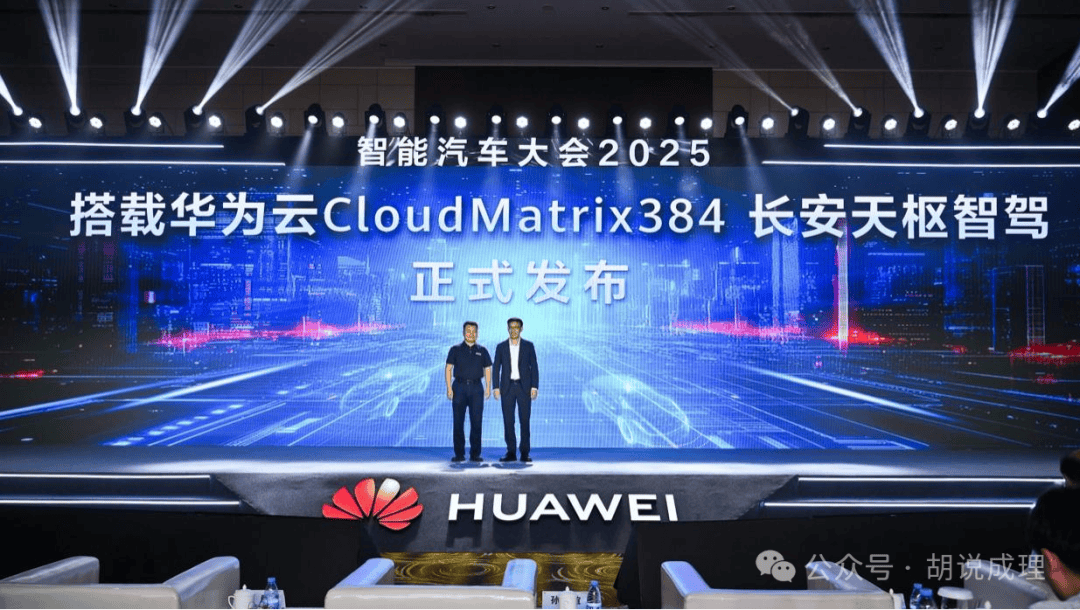
Image: Huawei Cloud CloudMatrix 384 Super Node Launch Ceremony for Changan Tianshu Intelligent Driving
Contrary to conventional thinking, certain niche, long-tail small scenarios require more vehicle-cloud collaboration. The emergence of the automotive zone has significantly optimized performance in these scenarios.
Currently, due to insufficient edge computing power, few vehicles can solve all scenarios with on-board chips alone. Vehicle-cloud collaboration, while a standard configuration, places high demands on computing power and communication capabilities.
The "thrilling" high-speed driving you envision is actually less demanding in terms of computing power due to the relatively simple driving environment. Conversely, scenarios like obstacles like debris placed behind the car body after parking, fallen fences, steel bars on construction site grounds, moving obstacles, and dimly lit parking spaces with blurry boundaries are beyond the capabilities of vehicle-end computing power.
Fortunately, these scenarios share a commonality: vehicles typically travel at very slow speeds, and car owners prioritize "stability" and "accuracy" over speed, providing a window of opportunity for vehicle-cloud collaboration.
The introduction of the automotive zone, and even its multi-location deployment, addresses such challenges. In complex scenarios like valet parking and low-speed cruising, "assisting vehicles with the cloud" to overcome the vehicle-end hardware computing power bottleneck is Huawei Cloud's specialty. Coupled with the unlimited cloud computing power and faster cloud model updates after multi-center deployment, a 15% increase in parking success rates has been achieved.
For ordinary drivers like us, the most tangible improvement is that the car's intelligent assistance system responds faster in these complex scenarios, significantly reducing the likelihood of getting stuck. This represents the most intense and tangible scenario for consumers.
Thirdly, the boundaries between cars and mobile phones are blurring.
Zhang Xiong, Director of the Product Department at GAC Group, posed an intriguing question on-site: automakers have observed that despite the increasingly rich and sophisticated in-vehicle infotainment (IVI) system functions, consumers still can't part with their mobile phones in car usage scenarios. To a certain extent, the higher the consistency between IVI system operation and mobile phone operation, the more convenient consumers find it.
However, this poses a challenge: flagship mobile phones are typically replaced every 3 years or less, while the IVI system's lifespan is equivalent to that of the car, which is 10 years or longer.
Consumers can't upgrade the IVI system hardware every 3 years, but Huawei Cloud's "cloud IVI system" offers a solution.
The concept of "cloud mobile phones" and similar ideas was proposed over a decade ago, and its fundamental theory remains unchanged today. The IVI system's configuration can be cheaper and simpler, with complex computing tasks delegated to the cloud. The IVI system serves as the "receiver" of results, significantly extending the IVI system's "useful life cycle" while reducing costs.
To provide a smoother, more durable, and more mobile phone-like experience for the IVI system, Huawei Cloud has jointly developed the CloudDevice cloud IVI system solution with Xingzhi, aiding GAC in upgrading the automotive cockpit screen experience. By enabling "computing and storage power on the cloud," consumers always use a "new IVI system." This experience is not only superior and less prone to lag but also reduces core chip costs by 20% and application integration cycles by 50%, particularly invigorating older models with outdated hardware specifications.
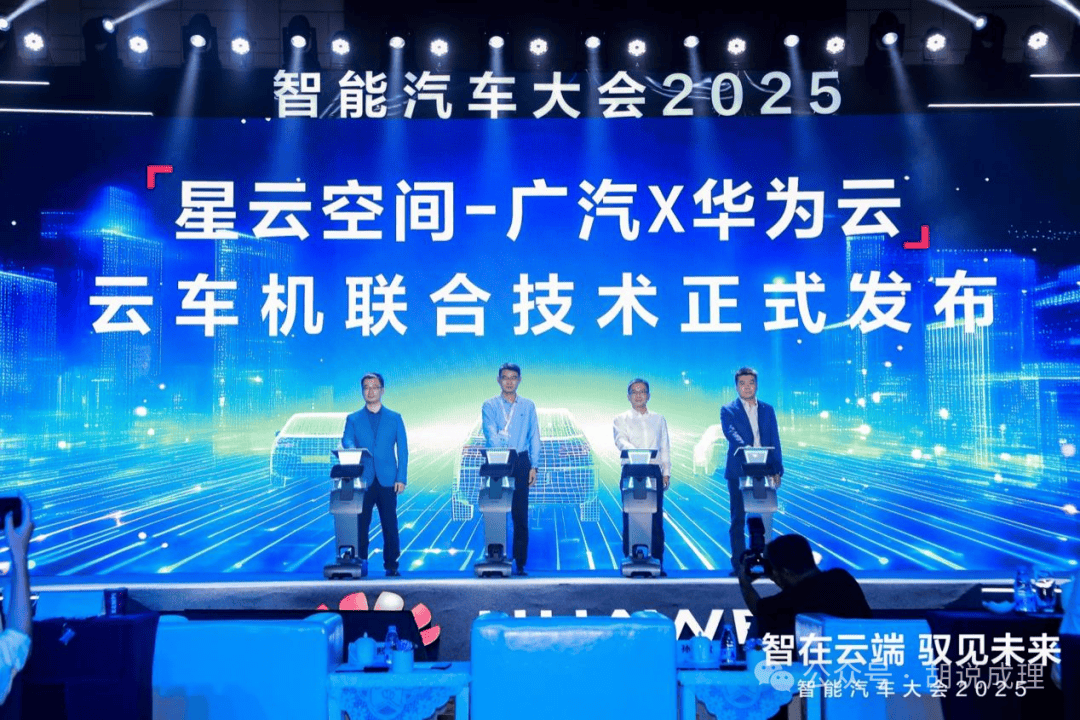
Figure: Nebula Space - GAC x Huawei Cloud Cloud IVI System Launch Ceremony
This is not just due to the computing and storage power provided by Huawei Cloud but also Huawei's deep expertise in vehicle communication as a major company rooted in communications. It gives consumers a clear perception: what you use on Huawei Cloud isn't just Huawei Cloud's technology but the culmination and innovation of Huawei's entire advantageous technology in the automotive ecosystem.
In fact, beyond various application-oriented technologies, it's evident that Huawei Cloud never applies technology for technology's sake but continuously refines its underlying capabilities, pursuing the optimal overall solution.
This is evident in the SFU (System Effective Computing Power) cluster indicator system launched by Huawei Cloud in collaboration with universities and automakers. This indicator system is based entirely on practical considerations, encompassing six-dimensional metrics: NPU resource utilization, host resource utilization, storage resource utilization, network resource utilization, task scheduling, and stability. This means that only Huawei can achieve core breakthroughs in higher-dimensional technologies to resolve many contradictions under existing conditions. The emergence of the SFU cluster indicator system not only creates a hexagonal warrior for the computing power cluster, enhancing its efficiency, but also breaks through the ceiling of the existing technical system supporting automotive cloud development, fostering a leapfrogging and disruptive new generation of intelligent computing systems and architectures. Ultimately, this serves China's intelligent automotive industry, positioning Huawei Cloud as a global leader in innovation for this grand yet specific goal.
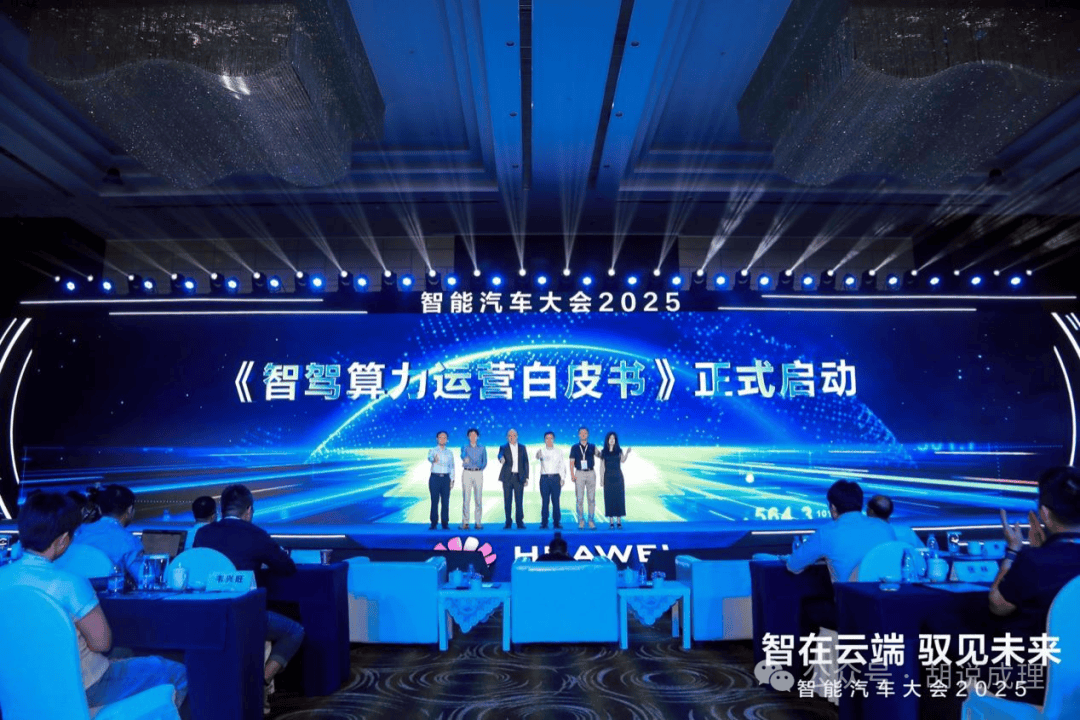
Figure: Launch Ceremony of the "Intelligent Driving Computing Power Operation White Paper"
Conclusion
Currently, the primary contradiction in the field of cloud computing has shifted from traditional resource sales to comprehensive solution sales, imposing higher demands on cloud vendors' technical expertise. Cloud vendors that merely "sell computing power" are unlikely to survive. From this perspective, Huawei Cloud's automotive zone points the way toward a dimensional upgrade, transitioning from cost-effectiveness competition to a comprehensive AI capability solution provider. This evolution is crucial in meeting the growing demand for advanced solutions across various aspects, including new high-quality training, inference, and intelligent driving assistance services.
However, amidst this prominent contradiction, the industry has bifurcated into two approaches: automakers spearheading the development of their complete technology stack or automakers collaborating with professional solution providers like Huawei Cloud's automotive zone.
For instance, Huawei Cloud's automotive zone offers a high-efficiency, high-quality data generation engine and an end-to-end closed-loop simulation solution. This helps users acquire high-value training and simulation data cost-effectively and swiftly, reducing scenario construction difficulty from 1 week to 5 minutes and shortening the R&D version iteration cycle from months to weeks.
This is challenging for automakers with limited ICT expertise and an annual average R&D expense that comprises only a small percentage of gross margin. As the industry progresses, competition increasingly becomes a technological battle, with the advantages of technology companies with an R&D expense ratio exceeding 20% becoming more pronounced.
To some extent, Huawei Cloud's automotive zone introduces a new paradigm: automakers are responsible for identifying pain points, defining scenarios, investigating demands, and finalizing products, while Huawei Cloud tackles the intricate and profound technical challenges mentioned above. Only when both parties concentrate on their respective strengths and collaborate fully can we address the core issues on the path to securing the global crown for intelligent vehicles.


